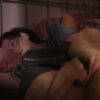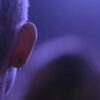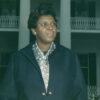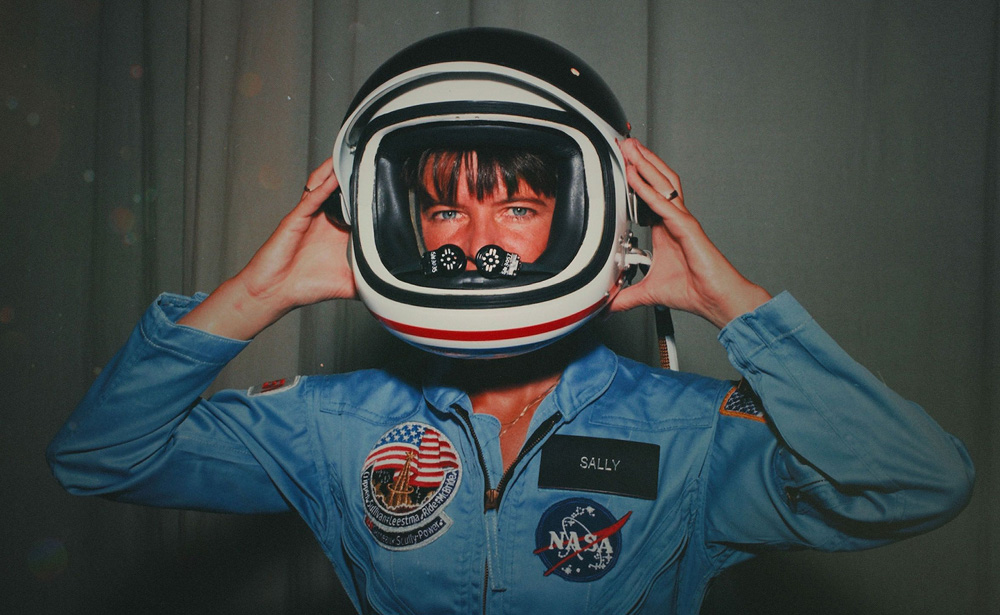Sparks fly in the exhilarating opening sequence of “Sally,” but not in the way you immediately imagine when you think about Sally Ride, the first female astronaut who made it into space. After painting a mural of Ride in the third grade, Cristina Costantini seemed destined to ultimately craft a portrait of her as she evolved into a top documentarian, but the person she saw as a youth, all smiles and uncomplicated in her heroism, was very different from the woman she only learned the truth about upon her death when her partner Tam O’Shaughnessy was finally acknowledged in her obituary, a surprise to millions of others. It changes the notion of meaning of “blast off” as familiar images of the Challenger space shuttle that took Ride to the heavens above are replayed, not only refreshed by the exacting restoration the filmmakers undertook to bring them back to their original glory, but by O’Shaughnessy getting to tell her side of the story for the first time so an icon who achieved so much can be admired for overcoming so much more than anyone knew. Still, it couldn’t have been easy to ultimately start a film by suggesting that everything audiences knew had been all wrong.
“Cristina was always very excited about doing this very epic launch in the beginning as a way of bringing people into the film and letting people know maybe this is not necessarily the narrative you think you’re going to see here. It’s not the standard space film,” says the film’s producer Lauren Cioffi of the bold opening. “Mostly everyone on the team was actually behind it, especially National Geographic — they were very much behind the idea of letting people know that this isn’t the story that you think you know about Sally Ride, and this is the way we all came together and thought, ‘Oh, this is how we could do that.’”
The only thing that may not be surprising about “Sally,” at least for those that pay attention to documentaries, is noticing Cioffi is in the credits when the producer has been behind some of the most exciting nonfiction films of recent years. After serving as a programmer at Sundance regularly boosting innovative nonfiction work, Cioffi has began to push the form further when teaming up with the likes of Liza Mandelup on the bleakly amusing influencer factory line doc “Jawline,” “Time” director Garrett Bradley for “Naomi Osaka,” and Nadia Hallgren on unexpected profiles of Michelle Obama and civil rights attorney Ben Crump in “Becoming” and “Civil,” respectively. The work may be largely unseen, but when serving as a bridge between some of the top companies in the field such as Dan Cogan and Liz Garbus’ Story Syndicate (“Sally”), Roger Ross Williams and Geoff Martz’s One Story Up (“Civil”) and Lance Oppenheim’s To Be Formed (“The Python Hunt”) and directors who have transcended ideas of being a mere fly on the wall in their pursuit of truth, Cioffi has no doubt nudged both to more daring ends.
The bulk of “Sally” may reside in the past when Costantini and crew sifted through hundreds of hours of archival footage to reconstruct Ride’s most famous exploits at NASA, but it is pulled into the present by O’Shaughnessy’s passionate recollections of her partner, as well as that of Bear Ride, Sally’s sister and others who knew her best, making her decision to hide her sexuality more understandable when she faced so much else as a part of a patriarchal culture at NASA and her marriage to a fellow astronaut was far more about checking off a box in her career than any needs she had in her personal life. Sequences of her stolen moments with O’Shaugnessy, a tennis pro who played the likes of Billie Jean King, are presented with equal vigor as her time in zero gravity, and while the film doesn’t diminish the accomplishment of weightlessness, it affords her another historically as it lifts the burden she had to bear for so long of not being truly who she was.
After premiering earlier this year at Sundance, “Sally” is being broadcast far and wide on National Geographic before it is available to stream on Hulu and Disney+ and Cioffi spoke about her path to helping put together a full picture of the pioneering astronaut as well as producing in general.
From what I understand, you got your start being on narrative film sets as a production assistant. How did the documentary world get so lucky to have you in it?
It’s true. I got a job at Sundance Film Festival, going into programming there specifically in docs and that’s what I think made me fall in love with docs. I did seven years on the programming team there and I just learned so much about all the players in the field, a lot about storytelling and just the rigorous critical thinking about the field. It just made me want to go into making more docs. There was something about narrative that wasn’t quite a fit for me and I think I just was drawn more to small crews, being able to go out on a dime and make things and not have to wait for so many pieces of the puzzle to come together.
You’ve also remained independent, which has allowed you to work with all of these exciting companies. Has it been interesting having that agency?
It’s something I wrestle with all the time, like should I go in house? But then I always come back to being independent because I think it’s really what allows me to work with so many different incredible directors and also so many different companies. It’s an opportunity for me to see how so many different people are working and glean a lot from that and through that come up with my own strategy of how I like to work. It also allows me to be really director-focused because I normally come on with the director first and then we go to companies together, so we’re able to make these choices that I think are specific to each film. We [can say] “Okay, this is a bigger series. We need more support on this. Maybe we’re going to work with a broadcaster on this,” or “this is a smaller, art forward doc. Maybe we’ll find the right production company for it.” It allows us to be nimble and choose the right partners for each project.
All of the projects you’ve worked on have been distinguished by having the clear touch of a specific director and I can recall talking to Nadia Hallgren about “Civil” where she credited you with literally picking up the camera for that film, given her past experience as a director of photography. That may be too literal an example, but how much of the job is convincing the filmmakers to be true to their own vision when I imagine there’s pressure to do something more conventional?
Each director that I work with has very specific strengths and things that they love. I’m a big proponent of figuring that out separately with each director and helping them move forward on that and part of that is being a strong liaison with the production company or with the network to help make sure that the director can actually realize those things, so a huge part of my job is helping the director identify the things that they’re really strong at and that they love and then making sure everybody else is on board with that part of the vision. In Nadia’s case, she was a 20-year-[veteran] DP and she was already directing so much on her own that I saw that in her and I was like, “Okay, let’s take this leap for you to direct and DP yourself.” That was a huge step for us in our collaboration and ultimately now she’s directing and I’m still working with Nadia all the time and that was a key move in our career.
How did you team up with Cristina Costantini for “Sally”?
When I was programming at Sundance, I really loved Cristina’s first two films “Science Fair” and “Mucho Mucho Amor.” I just thought she was a brilliant storyteller and somebody who was able to combine humor and then a lot of heart and emotion and warmth in one, which is a very hard thing to do. So I got to know Cristina through that and then when I left programming, Cristina reached out to me to come on to this film with her. She also knew that I was queer, so she was really excited about me being a voice to help shape the queer narrative of this and also work closely with Tam to feel comfortable to tell this story. She brought me onto the project and then I worked with Story Syndicate and National Geographic to make the whole film through development through all the way the end.
I’ve read a little bit about this 12-hour day of shooting the centerpiece interview with Tam. At what point in the process, do you actually want to do that? Is it all upfront?
We did Tam’s interview a little bit later in the process because we wanted to collect a bunch of stories with the astronauts and with Lynn Sherr, who had written the book [“Sally Ride: America’s First Woman in Space”] on Sally. We did many of those interviews so we could have a bulk of material to to then go into asking Tam as well and we had collected a bunch of archive [by that time]. Then we had a beautiful couple of days of working with Tam and we realized that she was such a vulnerable, emotional, and also very sharp and clever interviewee that we thought, “Okay, this could really be a lead narrator for the film.” She’s the interview that I think doc filmmakers dream of. She’s just so able to be settled and live in the details and remember so much that we thought this could potentially be the spine and narration for the film.
Was this generally a daunting prospect because it seems like both you and Cristina are more used to verite documentaries rather than archival-based, though you certainly both have a bit of that in your background.
Cristina and I have done a lot of verite, so working on an archival project was exciting in one way and I had done a series for HBO called “Love Has Won, The Cult of Mother God,” which was also a massive search for archive, so that was my other experience in watching 2,000 videos of live streams from the Love Has Won group. [laughs] Sally’s story was already written to some extent, so we knew what we were looking for, but collecting the archival on this film was a massive undertaking, especially because we wanted to try to find archive under every stone. That was our goal from the beginning and then up-res it and make it as beautiful as possible. So I worked really closely with our archival producer on this and also with NASA, who were really big supporters of this film. They gave us a ton of archive and Cristina and I went to the National Archives and found as much as we could there. But we had about 5,000 reels on this, so a lot of it was still a process of discovery, watching tons of stuff that was very minimally marked. Like maybe it said “Sally” or just “SDS-7.” Every reel we just watched and see what we could find there.
From what I’ve heard, a lot of the archival footage also wasn’t sound-synced. Did that make it more difficult to sift through?
It was definitely one of the greatest challenges of the project and something we didn’t know that much before we started. The sound was separate from the film, so whenever we would find these gems and these reels that we love, most of it did not have sound. Then we were able to find some sound and we went through the process of just trying to line it up manually and those are the moments in the films where you see the archival play out like verite and [we were first experiencing it] just listening to it in silence. The mission control footage was really exciting because that was one of the sequences that was able to be sound-synced, and we could cut that a little bit more like archival verite and you could live in the space of mission control. Sally was the first female mission control at NASA, so we really wanted the audience to experience that live with her and we really just held to keeping that as verite as possible so that you could be immersed in there. Then we worked with the interviews of the incredible astronauts who told some of the other stories that we lined up to bring those to life because they didn’t have audio [altogether].
Another great challenge in the film was that Tam and Sally almost had no photos of their relationship. I think we had like two or three, so in order to show the beauty and the details of how their romance unfolded, we would have to film these recreation sequences. That was something we learned very early on when we started meeting with Tam and we started to see the archive. Since they had to keep their relationship a secret, they just weren’t taking a bunch of photos of their romance, especially because if they were to get them developed, that could be something that could get out. So that was very limited and we knew that we wanted the audience to be immersed in their romance in the same way as they would be in the NASA footage, so we decided to do these abstract visuals [as a type of recreation]. That was another huge undertaking for the film and we went through the process of casting people who we thought embodied the spirit of Sally and Tam and then we did a three- or four-day shoot to bring this story to life for the audience because otherwise they wouldn’t have any visuals.
They really came out so beautifully, but when recreations generally are frowned upon and poorly executed, was that a hurdle to even start thinking about going down that road?
Yes, it was absolutely something that if you have the word recreations in your mind, it can go terribly wrong. One of the things we did was not use the word “recreations,” first of all, because that leads people to go down the wrong path. So we just started thinking about it in a different way. We didn’t want it to be completely literal. We didn’t want to show the people’s faces because we knew they would think too much about them. We wanted to create something that was a little bit more disconnected, more like living in the space of art, just so that people didn’t think of the bad recreations that we all know of. It was really important for us to make it elegant and blend with the film. We shot it on 16 millimeter for that reason, so that it could just blend as much as possible with the NASA footage of that time and we just worked really hard to take it out of the space of the cringey recreations that we’re all have in our minds.
What’s it been like to share this with audiences and seeing Tam finally get her due?
It’s been an incredible experience and Tam has been a wonderful collaborator. We were nervous and excited to share this film with Tam since she was so vulnerable and throughout the experience, her opinion was super important to us, so we were thrilled that Tam loved the film and she came to Sundance with us. In addition, Bear Ride, Sally’s sister, came to Sundance to support the film, and I think that the film was more than they ever could have imagined for this film.
In terms of audiences, when Cristina and I started making this with Story Syndicate and Nat Geo, all of us started two years ago and I don’t think we ever could have imagined that this film would be more relevant than ever, just the central idea that you have to hide a part of yourself in order to get to where you want to go in your career and in your life. That is something that we’re all experiencing right now. And two years ago, we were more nervous that Gen Z wouldn’t be able to relate to this film because they’ve always been so encouraged to be so out front about their queer identity and so unapologetic about it, which is amazing. But I think in this short period of time that a lot of that’s shifted. Audiences have really responded to that and I think they’ve been able to see Sally and Tam’s story as maybe a roadmap for how that can be so damaging to hide your relationship or hide a part of yourself, and at the same time, maybe it could potentially be a model for how to persevere. So far, audiences have really responded to that element of it and just seeing it through a new lens through this current climate, that’s been really powerful.
“Sally” will premiere on June 16th at 9/8c on National Geographic TV and will begin streaming on Disney+ and Hulu on June 17th.




